Ard-al-Moharbeen necropolis
 Palestinian excavators at the site in 2023 | |
| Location | Gaza Strip, Palestine |
|---|---|
| Type | Inhumation cemetery |
| History | |
| Periods | Roman |
| Site notes | |
| Discovered | 2022 |
| Excavation dates | 2023 |
| Archaeologists | René Elter[1] |
The Ard-al-Moharbeen necropolis was a Roman cemetery in the Gaza Strip, Palestine. It is the largest cemetery to have been discovered in Gaza and is thought to have been in use from the 1st century BC to the 2nd century AD. The necropolis was discovered in 2022 and excavated in 2023.
Discovery and investigation
[edit]The cemetery was discovered in February 2022 during construction work for a housing project. Archaeologists investigated the site and by the time the discovery was announced in 2023 they had found 125 tombs in an area of 4,000 square metres (43,000 sq ft).[2][3] Première Urgence and the École Biblique led the investigation, with the involvement of 30 graduates from Al-Azhar University – Gaza and the Islamic University of Gaza.[4]
The Israeli invasion of the Gaza Strip beginning in October 2023 led to hundreds of heritage sites being damaged.[5] In November that year, Jehad Yasin of the Ministry of Tourism and Antiquities reported that the cemetery was "almost completely destroyed".[6] UNESCO conducted remote monitoring of cultural heritage sites in the Gaza Strip and confirmed damage to the cemetery in its January 2024 assessment.[7][note 1]
Cemetery features
[edit]The Ard-al-Moharbeen necropolis is the largest cemetery discovered in Gaza and 135 graves have been identified.[1] Most of the graves still contained human remains. Some of the graves contained objects buried with the dead (grave goods); the objects include clay pots,[2] perfume bottles,[9] and some skeletons were found with coins in their mouths. The latter was a Greco-Roman practice and was intended to secure the deceased's entry to the underworld.[4][10]
Amongst the burials were two lead sarcophagi, the first to be discovered in Gaza.[2] One of the sarcophagi was taken to Qasr al-Basha, a museum in Gaza, for display to the public.[11] It is thought that some of the burials are of high-status Roman officials.[3] The burials are thought to date from the 1st century BC to the 2nd century AD.[12]
See also
[edit]- Anthedon – a nearby harbour active around the same time
- Blakhiya Byzantine cemetery
- Roman funerary practices
Notes
[edit]References
[edit]- ^ a b Adwan, Issam (23 September 2023). "Archaeologists unearth the largest cemetery ever discovered in Gaza and find rare lead sarcophogi". AP News. Retrieved 7 January 2025.
- ^ a b c Al-Mughrabi, Nidal (24 July 2023). "At least 125 tombs discovered at Roman-era cemetery in Gaza". Reuters. Retrieved 7 January 2025.
- ^ a b Francis, Ellen (25 July 2023). "125 tombs found after chance discovery of ancient Roman-era cemetery in Gaza". Washington Post. Retrieved 7 January 2025.
- ^ a b Velie, Elaine (27 July 2023). "Over 100 Tombs Unearthed in Roman Cemetery in Palestine". Hyperallergic. Retrieved 7 January 2025.
- ^ Ahmed, Kaamil (28 April 2024). "'Everything beautiful has been destroyed': Palestinians mourn a city in tatters". The Observer. ISSN 0029-7712. Retrieved 27 March 2024.
A recent report by the Palestinian culture ministry into Israeli damage to Palestinian heritage said Israel's bombardment of Gaza had destroyed 207 buildings of cultural or historical significance, including 144 in the old city and 25 religious sites.
- ^ Geranpayeh, Sarvy (28 November 2023). "Bombing of Gaza has damaged or destroyed more than 100 heritage sites, NGO report reveals". The Art Newspaper. Retrieved 7 January 2025.
- ^ "Gaza Strip: Damage assessment". UNESCO. Archived from the original on 30 January 2024. Retrieved 7 January 2025.
- ^ "Destruction of the Palestinian cultural heritage of Gaza – in pictures". The Guardian. 11 January 2024. Retrieved 7 January 2025.
- ^ Jacobs, Phie (3 August 2023). "Roman aristocrats bought passage to the underworld at this cemetery in Gaza". www.science.org. Retrieved 2025-01-13.
- ^ Stevens, Susan T. (1991). "Charon's Obol and Other Coins in Ancient Funerary Practice". Phoenix. 45 (3): 215–229. doi:10.2307/1088792.
- ^ "Archaeological new from Gaza". École Biblique. 30 June 2023. Retrieved 7 January 2025.
- ^ "Roman-era graves unearthed during excavations in Gaza's Roman Cemetery". WAFA News Agency. 23 September 2023. Retrieved 7 January 2025.
